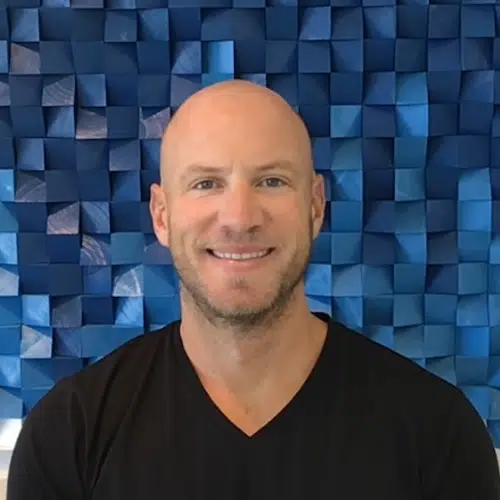The Arab Spring protests kicked off on December 17, 2010.
For two years, dictatorial governments across Tunisia, Libya, Egypt, Yemen, Syria, and Bahrain were challenged by their long-oppressed people.
This chain reaction also led to uprisings across Morocco, Iraq, Algeria, Lebanon, Jordan, Kuwait, Oman, and Sudan.
Social media’s ability to both mobilize and catalyze individual experiences in real time played a central role in empowering the masses to fight for their perceived injustice.
Then, on the other end of the spectrum, you have rampant disinformation.
Just like that – in the blink of an eye – social media goes from hero to villain.
And that’s only part of the reason why social media marketing continues to be misunderstood (at best) or divisive (at worst).
Because to understand how to do social media marketing properly, you first need to understand what social media is (and isn’t).
Social media is a catch-all term for any digital, interactive community. For instance, Twitter is a platform designed to let people share short messages and media links with others. Facebook, meanwhile, is a full-blown social networking site where users share updates, images and videos, join events and groups, and do a variety of other activities.
Social media marketing is the use of popular social media platforms to connect with your target audience and market your brand’s products and services.
Nothing in marketing is new.
For instance, “content marketing” might currently be en vogue. But it’s been around since at least 1900 when the Michelin tyre (with a “y”) company created the Michelin Guide books as a way to get tourists to drive more, sampling various restaurants throughout France.
A book. Celebrating restaurants and chefs. Created by a tire company. To sell more tires.
Sounds a whole lot like what we’re all doing today!
Incredibly, John Deere’s The Furrow actually beat the French upstarts by five years, with the first publication rolling out in 1885.
Social media is no different.
Social networks haven’t changed marketing. It isn’t some new-fangled thang. The underlying principles behind building an audience of active users on TikTok actually aren’t that different from doing the same inside AOL fan pages nearly two decades ago.
Sure, some obvious things are different. Tech standards have evolved tremendously. The rules of engagement are different. In other words, how you go about executing the tactics has evolved.
To better understand a social media marketing strategy, then, view it through the same 1960s lens as the 4Ps you learned on the very first day in Marketing 101:
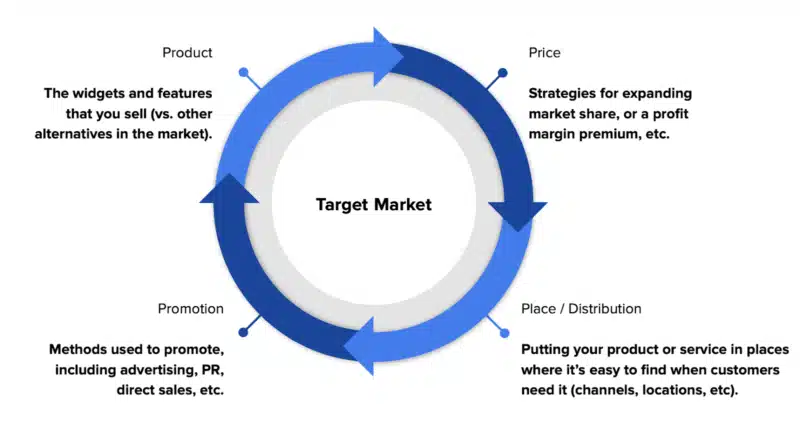
Most marketers today focus on the bottom two Ps to drive business goals:
- Promotion: This includes all the various ways to generate interest for your business, including advertising, PR, direct sales, word of mouth, and more.
- Place/Distribution: To strategically locate your brand in channels where your ideal customers will discover it.
A social media marketing plan is like an amalgamation of those two classic marketing principles that have been around since the golden days of advertising.
Social media marketing is an interactive, online water cooler operating 24/7 across every single time zone on the planet.
You can use it to develop awareness, produce and amplify authentic word of mouth (that used to and still does already happen offline), and at the same time foster loyalty with your organization’s zealots.
So it’s not “new” per se.
Social media marketing takes things that have already existed for decades, like the town square in some feudal state centuries ago, and combines it with a megaphone to amplify the same conversations across every other town just like it in the known world.
This can be confusing or off-putting to older generations that see “real life” and “social media” as two distinctly separate environments. Younger ones, however, typically don’t have that same point of view.
Imagine the impact of this quote from a recent Financial Times article. China, which actively monitors and censors its own social media alternatives like WeChat, recently started squashing “thousands of protestors” online, banning them for life.
Here are the grave consequences of that decision from one anonymous commentator:
“Erasing a social media presence is torture. I’ve lost connections with a lot of people. I’ve lost memories. I’ve lost possibilities.”
At its most extreme then, social media is like an extension of one’s offline life. It’s a digital identity that unites channels or mediums, coalescing everything from Gmail to Apple Pay to blogs and to YouTube.
Social media marketing perfectly aligns a brand’s business goals with how younger generations are already behaving
Sixty-odd years ago if you wanted to promote your widget, you focused on:
- Television ads across a handful of channels.
- Local radio ads.
- One of your city’s two newspapers.
- Catalogs in the mail.
Why?
Because that’s where the generations’ eyeballs were glued and it’s what influenced their willingness + ability to fork over hard-earned greenbacks.
But today?
Nearly all of those industries are languishing, dying a slow, painful death. While at the same time, teens literally can’t stop watching YouTube or quit their daily feed scrolling. More U.K. teens watch Netflix than the BBC.
Again, let’s revisit a classic marketing oldie-but-goodie – earned, owned, and paid media – to illustrate how social marketing fits into a broader promotional strategy.

Social media still sits firmly in the “earned” camp, because while it doesn’t require a ton of out-of-pocket spending, it does require you to roll up your sleeves.
And when combined with “owned” channels like your existing customer database, or “paid” ones like ads and influencer rev-share agreements, you’re able to generate more awareness or sales for a whole lot less than what any Super Bowl ad might run you.
Social media marketing also empowers search (SEO, visibility within each social network, recommendations from voice devices, and more)
Social media networks are essentially content and information-sharing platforms.
Each platform has its own search feature, allowing you to look up anything at any time. This means that:
- You can specifically optimize what you’re sharing to be found over and over and over again.
- This data can also be retrieved later for recommendations, not just for searching inside that one app, but from other apps and networks, too (think: Alexa voice commands and more).
This is a critical point because it means you should also be optimizing content differently based on where you’re posting or sharing it. Meaning:
- Facebook: Now the go-to B2C community for the mass market, 30-something-and-up generations.
- Instagram: Mobile-first, visually engaging photos or images sharing.
- LinkedIn: B2B discussions, polls, and knowledge exchange.
- Pinterest: A visual bookmarking and favoriting app for lists of lists.
- Snapchat: “Exclusive,” short-form, time-based ephemeral videos.
- TikTok: Short-form entertaining, inspiring, or educational videos.
- Twitter: Rapid-fire, short-form info and link sharing with a relatively quick half-life.
- YouTube: The de facto video-sharing platform for both short and long-form content.
Now that you know why social networks are so powerful, let’s turn our attention to the five critical advantages that make them one of the best investments for your time and money.
Get the daily newsletter search marketers rely on.
Social media marketing has some obvious disadvantages.
For starters, you can’t simply force-feed people some sterile, canned messaging like you used to be able to, without expecting some form of reply. Or what worked tactically yesterday on one channel, is almost guaranteed not to work tomorrow on the next one.
Thankfully, the positives far outweigh these negatives, though.
Here are five critical advantages of social media marketing.
1. Social’s increasing influence on search results
There’s a saying about Facebook that can now be applied to almost any other social channel.
People don’t go to Facebook (or TikTok, or LinkedIn, etc.) to work. They go there to avoid working.
One defining characteristic of social media, then, is the potential for serendipity.
You can find something or see recommendations that you weren’t necessarily looking for originally. So while great for discovery, this is also why social media doesn’t often ring the cash register as loudly as search does.
The good news is that search is increasingly being morphed and reformed with inputs from social media.
Most marketers have heard that YouTube is the second-biggest search engine on the planet. And that’s not wrong. But it also misses the full mark.
For starters, all of your search results are personalized. They’re influenced based on previous websites you’ve visited, videos watched, queries performed, and other connections you’ve made through that same digital identity that knits everything together (e.g., your Gmail account).
Search engine result pages (SERPs) are also now blended, showcasing different media types based on the query or question you’re dropping in.
As an example, type in a recent sporting event that just ended, like Liverpool (the good guys) vs. Man City (the bad guys), and you’ll immediately get YouTube suggestions including highlights, interviews, post-match reactions, and more.
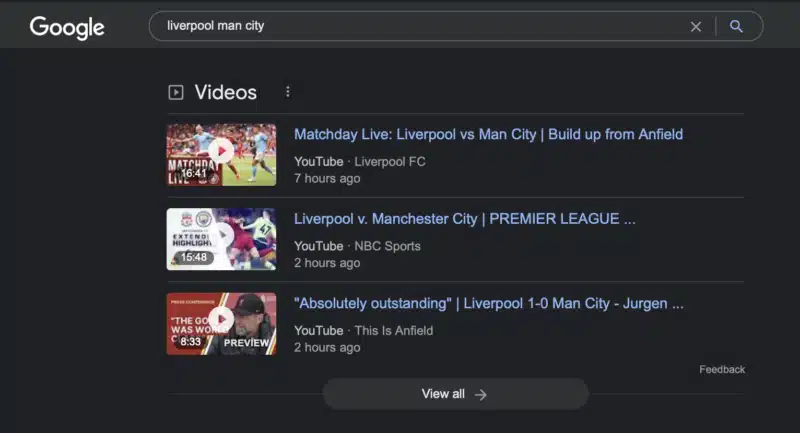
Note that this is before a single ad or traditional text-based link.
But that’s not all, either.
Keep scrolling and the second organic position is effectively a Twitter search, pulling in their firehose of never-ending content and surfacing the most respected journalists and publishers.

The ROI of search is among the best-performing marketing channels in the known world. It isn’t even close, because people type in exactly what they want and then you can show them that thing.
Now, guess what is continuing to impact those search results more and more? Social.
2. User-generated, multi-format content
Think back to how the Google SERP used to look. Ten blue links. Around three ads above those sometimes. And that was it.
Their goal was always to get you to the best possible answers to your queries, ASAP.
That’s evolved in recent years, too. You now have zero-click SERPs where Google provides instant answers so that a searcher never has to bother investigating in more detail.
So why pull in those YouTube results in the previous example, or the Twitter search field?
Because Google has realized that people want to read real-time discussions of people’s opinions for certain types of queries – and not simply get a link to another nameless, faceless corporation’s website.
They now know if you’re searching for “reviews,” you’re actually looking for comparisons, tutorials and walkthroughs – which means the best “answer” in this case isn’t a boring text-based article, but instead dynamic videos that flip between narrators and on-screen demos.
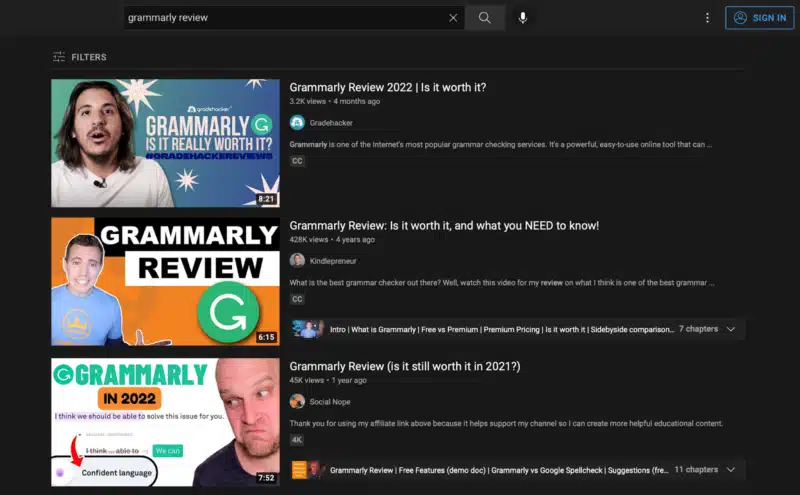
This is even more effective when it doesn’t come directly from your brand, but from other influential people that vouch for products or services on your behalf.
In the example below, Cuts Clothing is able to piggyback on Patrick Mahomes’ halo effect and let his user-generated social media content do the selling for them.

3. Different types of content amplify further, faster
Don’t shoot the messenger.
But the vast majority of people and companies out there will never just “go viral.”
It’s a pipe dream reserved for:
- The few massive brands with enormous leverage.
- Those that get lucky when the stars align once every century.
- Or those unlucky souls that do something so dumb or stupid they’re forever meme’d and GIF’d.
So let’s stop saying “viral” and call it “amplification” instead. Here’s a perfect example.
Len Markidan is a good marketer and a nice guy with a funny sense of humor. Nowhere was that more apparent than when he updated his LinkedIn profile to satirically point out how he “worked” at various social platforms because they’re all, frankly, stealing his data. (More on this in the next tip below.)
Within a few days, his “updated resume” did the rounds on LinkedIn, much to the amusement of other nerdy SaaS marketers.
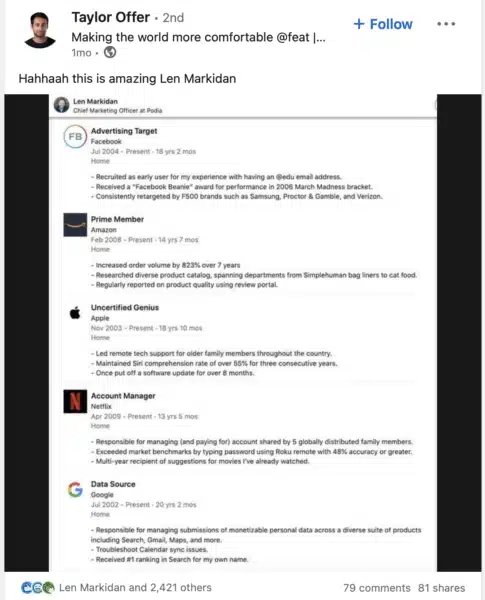
Reaching a few thousand people like this isn’t really the same as “going viral.” It wasn’t epic and it didn’t make him a legend overnight. But it’s a good start.
And it’s a perfect illustration of how you can tap into the network effects of social media platforms to amplify important/funny/persuasive/interesting/unexpected/touching messages if you know how to apply the right tactics at the right times.
4. Customer data increases ROI
Contrary to popular belief, social media campaigns aren’t “free.”
True, it is cheap (relatively speaking). Compare the CPM or CPC of a LinkedIn ad to billboards or television and we’re talking night and day.
One reason why social media advertising is much less expensive is that you can laser-target exactly who you want to reach, and therefore avoid overspending on crap that doesn’t benefit you.
If you want to run a radio ad, they might give you some zip codes, along with largely useless data points like household income.
If you want to run a LinkedIn ad, you can type in the exact location, role, and job titles of the target market you want to reach. You can even drill down into firmographics for the size of the company, how fast they’re growing, and other qualifying questions that help you determine whether they can afford your widget (or not).
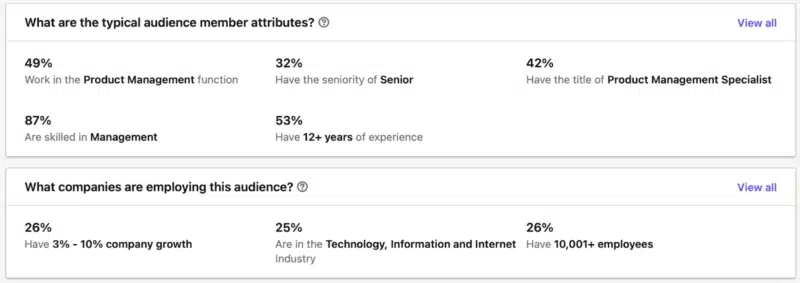
Context drives buying behavior today because it helps you better understand:
- The specific problems someone is dealing with which are holding them back.
- How they’re currently trying to solve or un-stick those problems.
- And, therefore, why your widget is better for them than the other alternatives in the market.
In other words, context is what drives everything from the ad placement to the creative. And context comes from customer data – knowing (almost) exactly who someone is, what motivates them, and why they decide to act (or not).
Then, you can build out custom segments of these people based on your knowledge, like if they’ve used your tool before or if they only visited your website one time without demoing or asking for a sample.
And you can target this context with ever-increasing granularity to deliver the right messages to the right audience at the right time.

5. Proactive and reactive audience building
Once you know how social media marketing should work, based on classic marketing principles, and how it’s more advantageous than other alternatives, you can know exactly how to get started using it to its fullest potential.
From a 30,000-foot view, you can start by categorizing it down into two distinct strategies: proactive and reactive.
Proactive publishing on social media helps you increase awareness with target audiences and stay on top of the radar for everyone from casual to die-hard fans.
The trick isn’t to create social media posts out of nothing, but to make them an extension of your ongoing content strategy.
You create search-driven content for your site or blog, or a specific theme for more shareable, social-friendly content. Then, you take those raw materials and mix, cut, edit, or repurpose them for each relevant social channel.
Everything is scheduled ahead of time, in advance, based on your larger marketing campaigns or launches that coincide with every other customer touch point (e.g., website, blog, email newsletter, etc.).

And then reporting can tell you not only how many engaged people you’re reaching, but more importantly the level of engagement of the audience as a whole (like reactions per post or per follower).
Reactive community management, on the other hand, can help you engage, foster, and amplify those messages across an ever-growing audience.
This includes basic interactions and customer service with people responding to your proactive messaging.
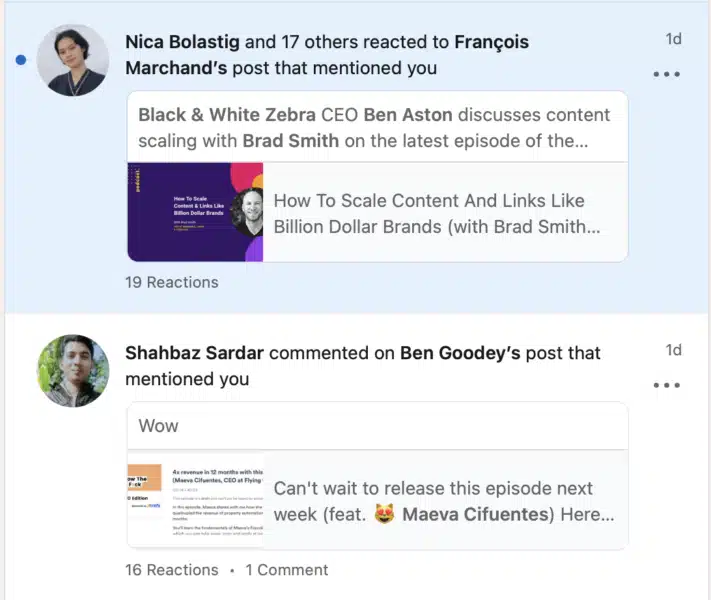
The trick is to get beyond the surface-level, easy-to-fake vanity metrics like “followers” to true thought leadership and marketing KPIs.
For instance, you can gauge how well your social media marketing is doing by looking at brand awareness as a proxy.
Go into Google Search Console and measure the number of branded clicks or impressions during the period. Then, contrast and compare this to the prior period (like the prior quarter) or the same time, prior year.

And because selling directly is tough via social (see: serendipity vs. search above), you can also look at leading indicators like newsletter opt-ins, event registrations, and other more middle-of-the-funnel offers to know how well you’ll be poised to drive sales in the near future.
Social media platforms haven’t fundamentally changed marketing.
In fact, you’ll have more success by making sure it’s well aligned with classic marketing principles you’re already familiar with.
Social media marketing combines both Promotion and Place (or Distribution) from the classic 4Ps and is one of the best examples of “earned” media.
In addition, the advantages of influencing search, user-generated and multi-format content, amplification, data, and audience building also make it one of the highest ROI activities you can choose today.
Yes, the way you tactically grow followers on Instagram is different than how you would optimize a video to top YouTube, which is also different from how you might write a Tweet thread.
But the underlying, timeless marketing principles that have grown businesses for literally centuries haven’t changed all that much.
It still isn’t too late to start using social media marketing or swap out your underperforming efforts with needle-moving ones.
Opinions expressed in this article are those of the guest author and not necessarily Search Engine Land. Staff authors are listed here.
New on Search Engine Land
